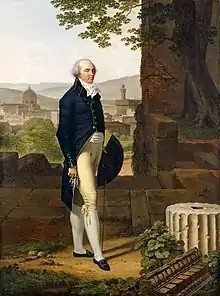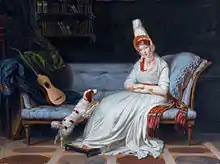Sir Godfrey Webster, 4th Baronet
Sir Godfrey Webster, 4th Baronet (25 December 1747 – 3 June 1800) was an English politician. He used the additional surname Vassall in the period 1795 to 1797.[1]

Life
He was the son of Sir Godfrey Webster, 3rd Baronet and Elizabeth Cooper of Lockington, Derbyshire, and nephew of Sir Whistler Webster, 2nd Baronet.[1][2]
In politics
In January 1780 Webster was on a Sussex committee set up to support the reformist Yorkshire Association.[3] In 1783 he was fighting in a Sussex reform meeting for a general petition.[4] In 1786 he entered parliament as MP for Seaford, with support from the Pelham interest, and after a petition.[1] Standing there again in 1790 with John Tarleton, he was defeated, but Tarleton was elected after a petition. He was back in Parliament in 1796, for Wareham.[5]
Personal life
Webster's uncle, the 2nd baronet, died in 1779, and about half a year later his father died in 1780, making him the 4th baronet. He inherited also Battle Abbey with its estate, but not with vacant possession since his aunt remained in residence.[6]
Webster was elected a Fellow of the Royal Society in 1786.[7] He committed suicide, shooting himself on 3 June 1800 after gambling losses.[5]
Family

Webster married in 1786 Elizabeth Vassall, daughter and heiress of Richard Vassall of Jamaica.[5] It was a disastrous union which ended in divorce after Elizabeth's repeated affairs with other men. They had three children, not including two sons who died young:
- Godfrey Vassall Webster, the 5th baronet;
- Henry Vassall Webster;
- Harriet Frances Webster, who married Fleetwood Pellew.[8][9]
Notes
- historyofparliamentonline.org, Webster, Sir Godfrey, 4th Bt. (1748-1800), of Battle Abbey, Suss.
- historyofparliamentonline.org, Webster, Sir Whistler, 2nd Bt. (c.1690-1779), of Battle Abbey, Suss.
- Christopher Wyvill (1794). Political papers, chiefly respecting the attempt of the county of York, and other considerable districts, commenced in 1799 ... to effect a reformation of the parliament of Great-Britain: collected by C. Wyvill. pp. 181–4. Retrieved 15 March 2013.
- Eugene C. Black (1963). Association: British Extraparliamentary Political Organization, 1769-1793. Harvard University Press. p. 102. ISBN 978-0-674-05000-6. Retrieved 15 March 2013.
- historyofparliamentonline.org, Vassall (afterwards Webster), Sir Godfrey, 4th Bt. (1747-1800), of Battle Abbey, Suss.
- Whittick, Christopher. "Webster family". Oxford Dictionary of National Biography (online ed.). Oxford University Press. doi:10.1093/ref:odnb/74132. (Subscription or UK public library membership required.)
- Thomas Thomson (1812). History of the Royal Society: From Its Institution to the End of the Eighteenth Century. R. Baldwin. p. lx. Retrieved 15 March 2013.
- Wright, C. J. "Fox, Elizabeth Vassall". Oxford Dictionary of National Biography (online ed.). Oxford University Press. doi:10.1093/ref:odnb/10028. (Subscription or UK public library membership required.)
- Lee, Sidney, ed. (1895). . Dictionary of National Biography. 44. London: Smith, Elder & Co.
| Baronetage of England | ||
|---|---|---|
| Preceded by Godfrey Webster |
Baronet (of Copthall) 1780–1800 |
Succeeded by Godfrey Webster |